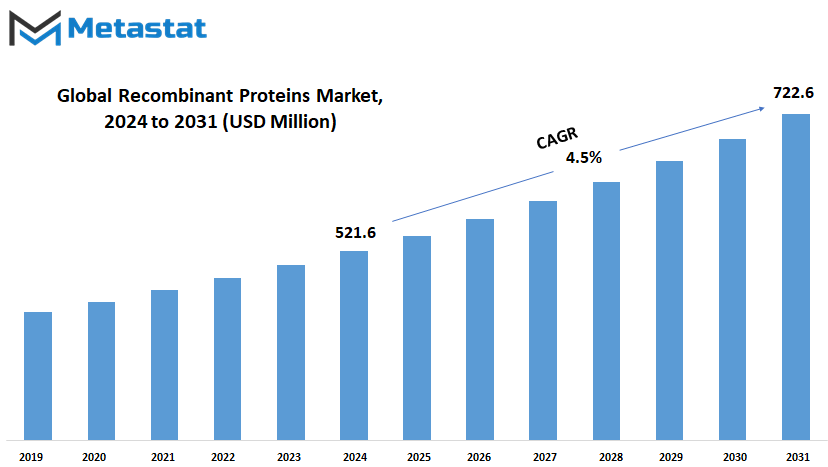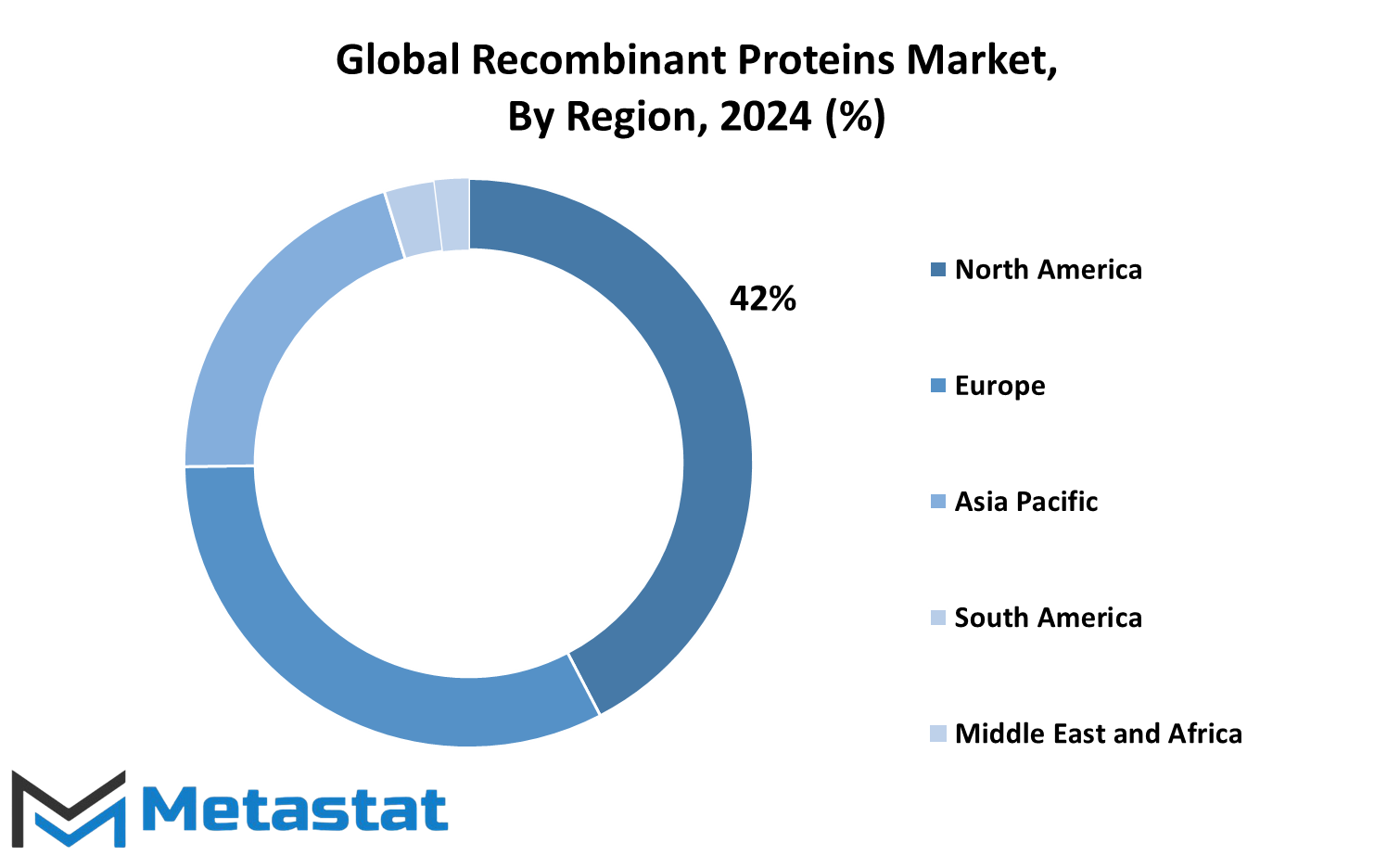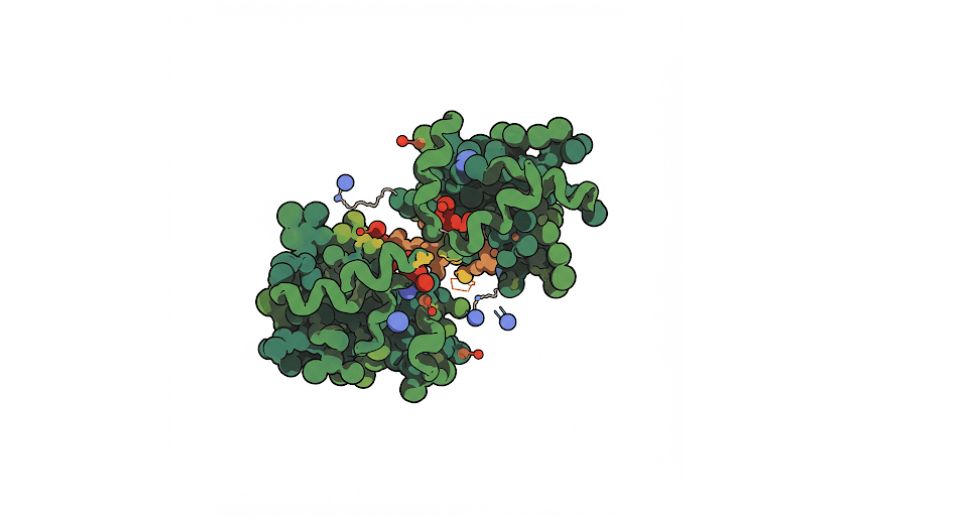MARKET OVERVIEW
This biotech and pharmaceutical industry is expected to undergo tremendous improvements with the advancements in these areas. The most predominant in this market will be recombinant proteins, which are produced from the recombinant DNA technique. It involves the insertion of a gene coding the protein of interest into the host organism so as to produce large amounts of that specific desired protein. These proteins have various applications, which are used in research, diagnostics, and therapeutics. As the depth of medical research is found to be increasing, with greater demand for targeted therapies, it will also increase the necessity of recombinant proteins across different domains such as oncology, immunology, and genetic disorders.
The Global Recombinant Proteins market will span multiple sectors with diverse applications. Pharmaceutical companies will begin to rely on recombinant proteins for the development of biologic drugs, mainly monoclonal antibodies, enzymes, and vaccines. In research institutions, recombinant proteins will still be used experimentally, contributing to scientists' discovery of disease mechanisms and innovative therapies. Diagnostic labs will also take advantage of the proteins in tests and assays that detect specific biomarkers or pathogens. For the time being, significant growth can be expected for recombinant proteins in the market that also concerns gene therapy and precision medicine, as their role there is critical to personalized medicine.
Market development will also be majorly seen both in developing countries and emerging countries. Prime Locations among other places will include North America due to having established Industries of Biotechnology and Pharmaceuticals. Nonetheless, the investments in biotechnology research and infrastructure will rise in Asia-Pacific, Latin America, and the Middle East. The recombinant proteins market will rise further. It will also become a future source of production and distribution for the recombinant proteins, which will be further driven by biotechnology advancement.
As regulations involving the development and use of recombinant proteins become tighter, the global recombinant proteins market is expected to shift in its compliance standards. These changes would affect the way companies produce as well as use recombinant proteins. Regulation and safety requirements, quality control checks, and clinical trial requirements will take up an upper hand in regulating the development, production, and sale of recombinant proteins. In the future, companies would have to meet ever-rising demands for consistency and reliability in recombinant protein products while dealing with complexities associated with patent laws and intellectual property concerns. This regulatory environment is going to challenge companies into innovation and efficiency in production methods to adopt advanced technologies such as cell-free systems, next-generation expression platforms, and innovative purification processes.
Technologically, the future of this market is heavily dependent on technology. The next ten years will certainly see us bettering and reducing the costs of these techniques for productions. Innovations like gene editing, synthetic biology, or automated protein synthesis systems are going to make it even easier and faster to produce these recombinant proteins while making it cheaper at the same time. It does not only expose the proteins but challenges more people to research further therapeutic uses for them. Therefore, by these technologies, the market for recombinant proteins into the future will be defined for new avenues in drug developments, diagnostics, and therapeutic treatments.
Technological advancement, changes in regulation, and shifts in healthcare needs are driving the global recombinant proteins market into a new phase of development. The market is changing in the light of innovations that impact both the pharmaceutical and biotechnology sectors and drive further human health. In response to emerging challenges and opportunities, recombinant proteins will assume more prominent positions in delivering improved outcomes for patients everywhere.
Global Recombinant Proteins market is estimated to reach $722.6 Million by 2031; growing at a CAGR of 4.5% from 2024 to 2031.

GROWTH FACTORS
The global recombinant proteins market is growing and will experience further growth in the upcoming years. Several factors are responsible for its growth, namely, developments in biotechnology and growing healthcare needs. Now that research in biotechnology has advanced, recombinant proteins are better produced. That sets on a higher supply of good-quality proteins for both research, diagnostics, and therapeutic purposes-the key driver of this market in the future.
One of the main growth drivers for the Global Recombinant Proteins market is the increased demand for biologics in the pharmaceutical industry. The production of therapeutic drugs requires recombinant proteins, particularly in the treatment of different diseases such as cancer, autoimmune disorders, and metabolic diseases. With an aging global population and the growing prevalence of chronic conditions, demand for such treatments will likely increase. With the advanced state of medical research, the usage of recombinant proteins in drug development would only increase in importance.
Rise in the focus on the application of personalized medicine in pharmaceuticals is another variable which will lead to this increase in the Global Recombinant Proteins market. As medicine becomes individualistic, the demand for targeted proteins that can target specific genetic or molecular markers will rise. Recombinant proteins will be at the center of these treatments because they can now be engineered to match particular demands for a given patient. This will push further innovation in recombinant protein technology, fueling expansion in the market.
Besides this, improvements in genetic engineering and protein expression systems will also be contributing factors in terms of growth. Such increased efficiency and volume will cut down the production costs and will increase the availability, thus making recombinant proteins more accessible over time for such applications as diagnostics, development of vaccines, and construction of new therapeutic treatments.
Even though the world is gradually moving towards a more environmentally friendly solution, recombinant protein production provides a greener option compared to conventionally produced animal or plant proteins. The industry's market future will take another step in that direction as the production moves toward microbial usage, including bacteria and yeast.
On balance, the Global Recombinant Proteins market will be characterized with a remarkable growth rate over technology advancing, growing health care demand, and rising demand of biologics and more personalized treatments. This way, the future will go well by driving the market into highly innovative applications and will bring the world close, further to recombinant proteins at work.
MARKET SEGMENTATION
By Product Type
One of the main categories for the Global Recombinant Proteins market is immune response proteins. These proteins play a very essential role in many of the operations of the immune system, making them increasingly used in both immunotherapy and the designing of vaccines. With the rise in incidence of autoimmune diseases, cancers, and infectious diseases, there will be a surge in demand for immune response proteins. In the other category, structural proteins, which have been used in various fields like tissue engineering and wound healing, will have increased demand due to the ever-increasing number of aged people and regenerative medicine.
Enzymes and regulatory proteins are the two important parts of this market. Enzymes find applications in drug development, tests during diagnosis, and food processing. While this is the case, it must be noted that regulatory proteins assume central roles in controlling cellular activities. With medical research currently pursuing tailoring medicine to suit more appropriate and effective treatments, use of enzymes and regulatory proteins would be more extensive since it has broader applications. Hormones and growth factors are bound to increase in demand quite substantially, especially as regards the conditions associated with hormonal imbalance and growth disorders. It will be a further augmentation in the use of recombinant hormones and growth factors regarding the worldwide growth of these diseases.
The next product category is the viral proteins, which are crucial products for research and formulating vaccines. With continued attempts to solve issues associated with health emergencies such as pandemics, demands for viral proteins will continue to increase. Kinase proteins, which are a part of the regulation of cell signaling, and adhesion molecules, which are involved in cell interactions, will also be in demand. These proteins are crucial in cancer research, inflammation studies, and drug development, and their use is likely to increase with new therapeutic approaches.
The Global Recombinant Proteins market will most probably expand further in the future with ongoing advances in biotechnology and increased attention on personalized medicine. It is a market that is likely to continue offering new opportunities for growth as recombinant proteins are applied in new and innovative ways to treat diseases and improve healthcare outcomes.
By Application
Global recombinant proteins are still a rapidly growing and active entity, great in almost all scientific and medical applications. Recombinant proteins are defined as proteins resulting from the product of insertion of a gene into a host organism which can be bacterial, yeast or mammalian cells. This feature of genetic engineering has transformed protein production to be used in different applications from drug discovery and development up to medical therapy. This demand for recombinant proteins is going to further increase because of new technological breakthroughs that are expected in the following years.
They provide scope for investigations into more about the characteristics of the proteins and in developing novel drugs. It also provides high importance in discovering possible drug candidates, mechanisms responsible for diseases, and validation of drugs. It is one step towards new therapies and vaccines. Recombinant proteins will more than ever before contribute toward drugs discovery and development as pharmaceutical companies try to aim for the final milestone, where targeted therapy could potentially heal a broad array of diseases. Recombinant proteins are also widely used in biotechnology research. They have been used in the study of gene expression, protein-protein interactions, and protein folding. They have been crucial in understanding biological processes and in the development of new biotechnological tools. In the future, we can expect that the use of recombinant proteins will be significantly increased in genetic engineering and synthetic biology, which are areas of great promise for breakthroughs in medicine and agriculture.
The diagnostic sector will greatly be developed with the use of recombinant proteins. They are applied in tests that will be able to diagnose disease, track patient health, and design new diagnostic techniques. The development of recombinant proteins facilitates the preparation of very specific antibodies and antigens used in diagnostic assays. Thus, recombinant proteins will increasingly be more central to diagnostic testing with the growing need for accurate and early detection of diseases.
Recombinant proteins will also be of therapeutic use, as many biopharmaceutical products, such as insulin, growth factors, and monoclonal antibodies, are prepared through recombinant DNA technology. Such therapies treat the most common diseases and ailments, from diabetes to cancer. The future production of personalized medicine will rely heavily on recombinant proteins because they can be produced in different forms to suit individual patients.
Continued innovative drivers by academic and scientific research will be the discovery of further areas of the application of recombinant proteins through continuing explorations in basic biology, medicine, and even environmental science, the more knowledge achieved about genetics and how proteins function, the larger the applications will be to boost the market.
By End-User
Therefore, as expected, these high positions would be taken over by big-pharmaceutical and biotechnological houses. These companies finally share out the new drugs as well as the therapeutics through the technology of recombinant protein engineering developed to offer superior remedies in disease conditions.
The recombinant proteins have critical importance in biologics where drugs are produced from living organisms and are applied for various disease treatments. As more of the biotechnology companies build upon their research and development capabilities, this will place further demand on proteins, so again, it will be possible for this market to even be more dynamic and competitive. The significant utilization of recombinant proteins is by pharmaceutical companies that are preparing vaccines and gene therapies. Due to critical health issues that the world faced, there has been growing demand in both vaccines and gene therapies.
Recombinant proteins are also part of the needs of research and academic institutions in basic research studies, like molecular biology, cell signaling, and protein functions. Demand for recombinant proteins is going to surge in the near future based on growing interest in genetic research and personalized medicine. More partnership and advancement in scientific knowledge as this trend develops are sure to come from greater collaboration between academic and research institutions with pharmaceutical companies, further boosting demand for high-quality recombinant proteins.
Diagnostic labs are the second crucial segment of the recombinant proteins market. In diagnostic laboratories, recombinant proteins are utilized to run diagnostic tests that enable an accurate diagnosis of diseases, follow disease progression, and determine if a treatment is working properly. In precision medicine, recombinant proteins will find extensive use in diagnostic labs because these tests require accurate and specific results.
One major player in this industry are Contract Research Organizations (CROs). CROs service the discovery and development companies in the fields of pharmaceutical and biotechnology. Among the services are drug discovery, preclinical research, clinical trials, and regulatory compliance. As these organizations will continually make the drug development process less stressful and easier, they will consequently become a significant demand for recombinant proteins, which at all stages of testing and developing drugs will be highly required.
Hospitals and clinical laboratories are among the other major consumers of recombinant proteins. It is used in hospitals and clinical laboratories for therapeutic and diagnostic purposes. As health care services continue to expand throughout the world, hospitals are always going to be in constant demand for recombinant proteins used for the treatment of patients, mainly for diseases requiring biologic drugs and personalized therapies.
With new technology advancements and rising demand in the other segments, the recombinant proteins market is sure to continue to grow on a global level. This would help these end-users further apply recombinant proteins in newer, innovative ways. And, consequently, it will drive tremendous advancements in medicine, research, and diagnostics.
|
Forecast Period |
2024-2031 |
|
Market Size in 2024 |
$521.6 million |
|
Market Size by 2031 |
$722.6 Million |
|
Growth Rate from 2024 to 2031 |
4.5% |
|
Base Year |
2022 |
|
Regions Covered |
North America, Europe, Asia-Pacific Green, South America, Middle East & Africa |
REGIONAL ANALYSIS
The recombinant proteins market is diversified, diverse, and growing with an incredible speed in the global geography that takes on a pivotal role in their growth and development. There is a wide presence in markets across the globe in varying proportions that contribute uniquely to the total dynamics. North America, Europe, Asia-Pacific, South America, and the Middle East & Africa mark as major regions offering recombination proteins. It can be explained through factors related to technology advancement, healthcare structure, and research and development.
Major players in the market of recombinant proteins in North America are U.S., Canada, and Mexico. In the United States in particular, biotechnology is highly invested, which supports the high rate of recombination proteins both in research and the therapeutic area. Significant investments in biopharmaceuticals along with continuous research activities have made North America, which will likely maintain its leadership at least for the next several decades. The demand for recombinant proteins is growing in this region, which is mainly attributed to growth in personalized medicine, rising research in cancer therapies, and advancement in vaccine development.
Europe, including the UK, Germany, France, and Italy, is another major region in the global recombinant proteins market. Advanced healthcare systems and a strong focus on biotechnology research make Europe a significant player. The increasing number of biotech startups and pharmaceutical collaboration with academic institutions is going to favor the growth in the region of recombinant proteins. In this regard, the region will witness growth in coming years with the increasing requirements of protein-based advanced therapeutics and therapies.
Some of the nations of the Asia-Pacific region that are turning out to be more crucial markets for recombinant proteins include India, China, Japan, and South Korea. China and India, with its huge population size and exploding biotechnology industries, shall witness an upsurge in demand. Moreover, these countries are focusing on the development of health infrastructure and investment in research and development to have a better position in the global market. Japan and South Korea are leaders in the innovation of biotechnology, and this will further accelerate the application of recombinant proteins in research and medicine.
Gradually, countries like Brazil and Argentina along with other South American states are adopting recombinant proteins. Although in its initial stage, the market is becoming enormous as it involves health-related investment and a growing need to improve the treatments. The government activities and increased access to health in the region will drive this South American market into its future.
Reconstructive proteins market is set to grow steadily in the Middle East & Africa, including countries in the GCC, Egypt, South Africa, etc. The demand for a better healthcare service and also biotechnology innovations in the region will boost the applications of recombinant proteins both in therapeutic and diagnostic interventions, though this market is under constant development, and there seems a growing awareness and interest over time in biotechnology solutions of proven improved healthcare outcomes.
Looking ahead, each of these regions will continue to make their contributions to the overall growth of the global recombinant proteins market. The strength of each region will define how the market will grow: for example, North America has technological leadership, Europe's growth is research-driven, Asia-Pacific has manufacturing capacity, South America has an expanding healthcare infrastructure, and the Middle East & Africa have an emerging biotech sector.

COMPETITIVE PLAYERS
The Global Recombinant Proteins market is highly competitive and dominated by many major players, making it an industry of high growth rate. In this area, companies focus on developing and manufacturing recombinant proteins which are essential in a variety of biotechnological applications like therapeutic drugs, vaccines, and diagnostic tools. These proteins are produced when the gene of interest is inserted in a host cell, then the protein synthesized in enormous quantities. These make them of great importance in modern biotechnology.
One of the market leaders, Amgen Inc. has well established itself as a name owing to its novel application in biotechnology toward producing monoclonal antibodies and therapeutic proteins as some other products. Amgen's genetically engineered expression systems confer a competitive edge with the rest of the crowd in the market since it leads other companies competing in this heavily competitive sector.
Another major player is Biocon Ltd., which is based in India. The company has taken major strides in the recombinant proteins market, with an emphasis on the production of insulin and other therapeutic proteins. The strong research and development capabilities of Biocon have allowed it to expand its product portfolio and increase its presence in the global market.
The game has another significant player, a South Korean biotechnology company known as Celltrion Inc. Specialized in the biosimilar area, including recombinant proteins, Celltrion was able to offer high-quality, low-priced alternatives to branded biologics, gaining important market share both in emerging and developed markets.
Dr. Reddy's Laboratories Ltd. is marking its presence in the pharmaceutical industry with a focus on biosimilars and recombinant protein therapies. It has an increasingly extensive list of biosimilars well poised to compete in the recombinant proteins market with the rising demand for cheaper therapeutic options.
Some other significant players in the global recombinant proteins market are Merck KGaA, Pfizer Inc., and Samsung Bioepis Co. Due to the strongest R&D activity in terms of protein development, Merck KGaA leads in terms of developing proteins, followed by Pfizer Inc. in relation to the enormous scope and unrestricted resource availability; such a drug-maker, again one of the biggest in that niche. Samsung Bioepis Co. holds some strong footholds on biosimilar front and newer recombinant therapies.
This list includes Sandoz International GmbH, Stada Arzneimittel AG, and Teva Pharmaceutical Industries Ltd. These companies had specifically focused more on expanding the recombinant protein portfolio and advancing the development of biosimilar products to contribute to and meet the requirements arising from expanding demand for inexpensive and effective therapies in global healthcare sectors.
As the global market for recombinant proteins continues to expand, these firms can be expected to be at or near the forefront of that trend, fueling both innovation and competition. Growing demand for biologics and continuously advancing therapy requirements guarantee dynamic competition between incumbent leaders and new entrant biotech companies.
Recombinant Proteins Market Key Segments:
By Product Type
- Immune Response Proteins
- Structural Proteins
- Enzymes and Regulatory Proteins
- Hormones and Growth Factors
- Viral Proteins
- Kinase Proteins
- Adhesion Molecules
- Other Recombinant Proteins
By Application
- Drug Discovery and Development
- Biotechnology Research
- Diagnostics (In Vitro and Clinical)
- Therapeutics
- Academic and Scientific Research
- Biopharmaceutical Production
By End-User
- Pharmaceutical and Biotechnology Companies
- Research and Academic Institutions
- Diagnostic Laboratories
- Contract Research Organizations (CROs)
- Hospitals and Clinical Laboratories
Key Global Recombinant Proteins Industry Players
- Amgen Inc
- Biocon Ltd.
- Celltrion Inc.
- Dr. Reddy's Laboratories Ltd.
- Merck KGaA
- Pfizer Inc.
- Samsung Bioepis Co.
- Sandoz International GmbH
- Stada Arzneimittel AG
- Teva Pharmaceutical Industries Ltd.
WHAT REPORT PROVIDES
- Full in-depth analysis of the parent Industry
- Important changes in market and its dynamics
- Segmentation details of the market
- Former, on-going, and projected market analysis in terms of volume and value
- Assessment of niche industry developments
- Market share analysis
- Key strategies of major players
- Emerging segments and regional growth potential






_Market_pr.jpg)

 US: +1 3023308252
US: +1 3023308252






